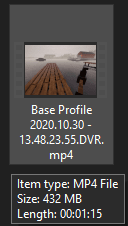

It was approved in July 2020 and is expected to be the most advanced compression technology among others.Īs you can see, there is a variety of co-existing codec standards, all of them continuously evolving and competing. It is actively adopted in popular streaming services on YouTube, Netflix, etc. The first stable release happened on the 28th March 2018. AV1 is a modern and royalty free codec.In spite of its efficiency, HEVC is poorly adopted due to uncertain and non-FRAND ( Fair, Reasonable and Non-Discriminatory) licensing terms. HEVC (H.265) is a great technology drafted in 2013.Current popular codecs are AVC (H.264) and VP9 (used in many popular streaming services, WebRTC, YouTube, Twitch).The comparison of codecs is a large topic for another article, but here I’ll just share some key facts: Open source/royalty free: VP8 -> VP9 -> AV1.Royalty codecs (ITU/MPEG): AVC -> HEVC -> VVC.Photo by Flavio Gasperini on Unsplash So many codec namesĪVC, VP8, VP9, HEVC and modern AV1, VVC - what are all these? And why so many of them?Īll these abbreviations are different codecs. So here I’ve explained why we need codecs and presented an overview of how they work. After that, I understood that what’s really needed is a short, simple article about it. A small article about how the video codecs work and why this technology is so important for the modern media industry.īackground: the intent of this article was born out of a discussion with my friends about media software: how it works and why it’s important.


 0 kommentar(er)
0 kommentar(er)
